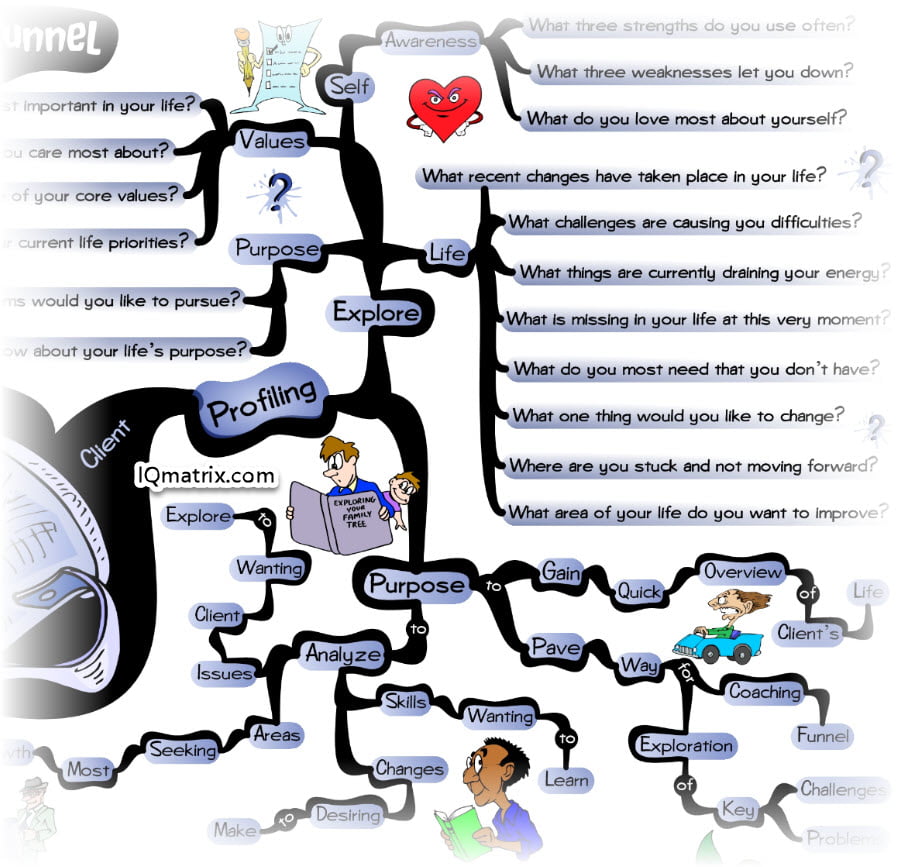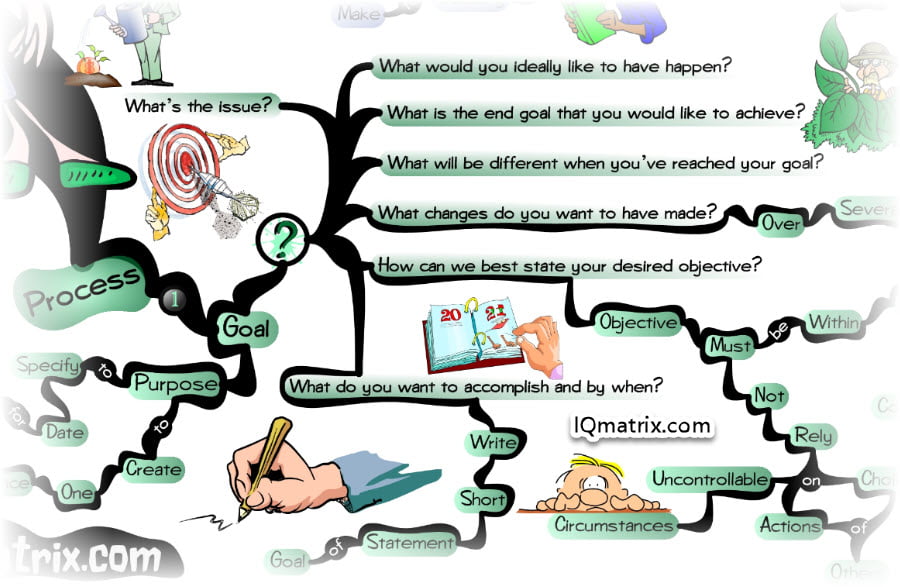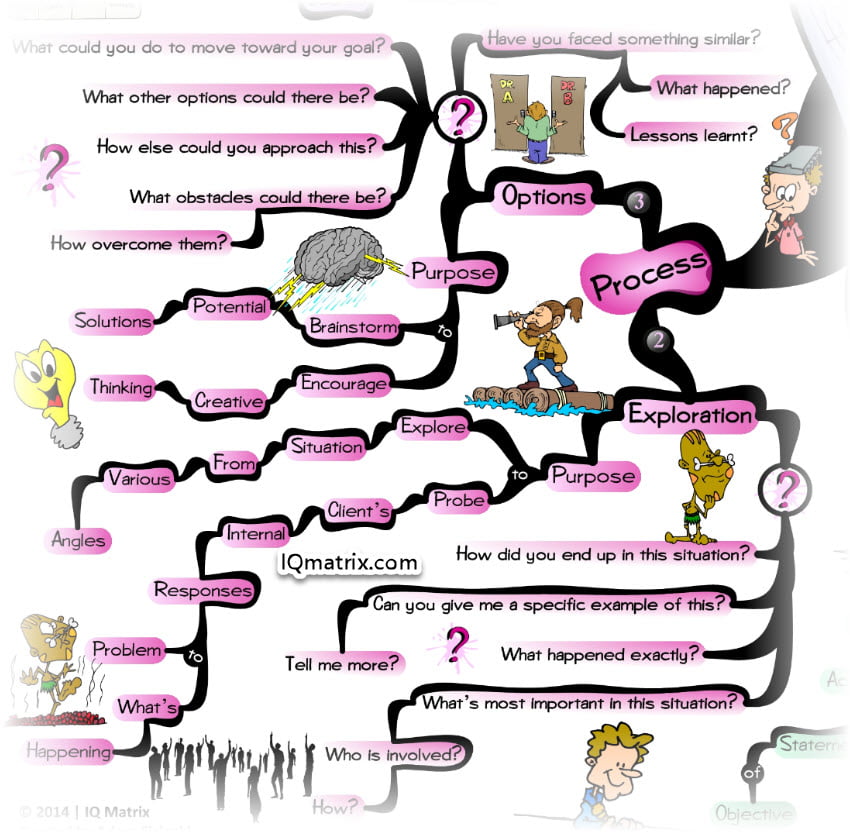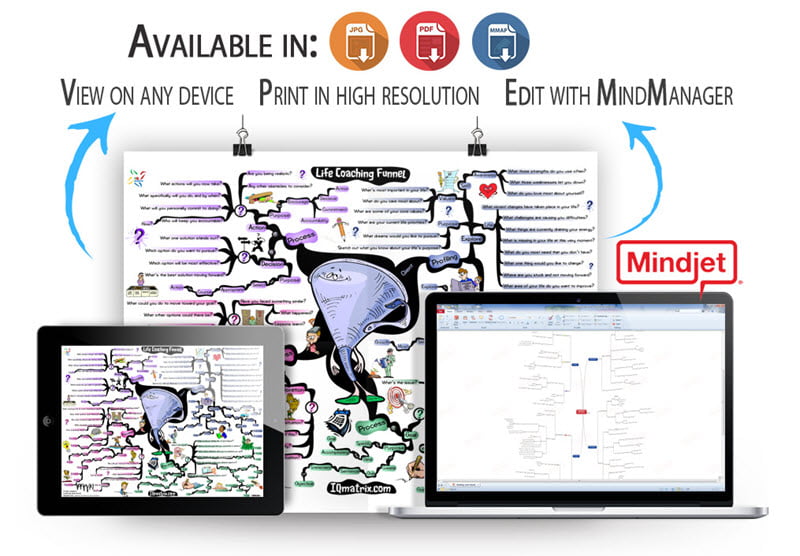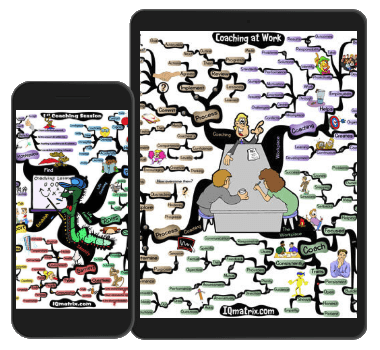A real decision is measured by the fact that you’ve taken new action. If there’s no action, you haven’t truly decided. – Anthony Robbins
This article is part of a series of five articles that walk you through various questioning methods and models typically used for life coaching purposes. However, these questions can also be used for self-coaching purposes to help you gather more insights about your life, problems, and circumstances.
Here is a list of all articles included in this series:
- The GROW Model
- The Life Coaching Wheel
- The Life Coaching Funnel
- The Problem Solving Model
- The Decision Making Model
The Purpose of the Life Coaching Funnel
Life Coaching is about asking an optimal set of questions that can help your client gain the clarity they need to overcome a challenge, solve a problem or achieve a desired goal. Along the way, life coaches use a variety of questioning methods and tools that help challenge how their client thinks about their life and circumstances in optimal and helpful ways. One of these tools is known as the Life Coaching Funnel.
The Life Coaching Funnel presents a client with a series of questions that moves them from the formulation of a goal toward an action plan for the attainment of that goal.
We’ve of course previously discussed the Life Coaching Wheel. This is also built upon a series of questions that helps a life coach and client gather the necessary insights they need to set in motion a direction and path for upcoming coaching sessions.
The Life Coaching Wheel helps identify key life areas that a client would like to focus on and potentially work through in more optimal ways. The Life Coaching Funnel is then used as a follow-up questioning process that helps you explore specific areas in much more depth and detail.
In a nutshell, the Life Coaching Funnel is used to help your client move from point A to point B, step-by-step — working through a very specific goal that they would like to achieve. This goal is of course tied to one of the key life areas identified within the Life Coaching Wheel. It’s often an area where they are not living up to their full potential.
To put this another way, the purpose of the Life Coaching Funnel is to use several carefully laid out questions to walk a client through a series of steps that helps them to transition from focusing on a problem, toward building a plan of action that’s centered around a very specific goal that they would like to achieve.
The process involves four distinct stages as well as an additional preliminary stage that helps the life coach profile a client in order to gain the necessary information they need to move through the Life Coaching Funnel in an optimal way.
Let’s now explore each of these stages individually.
The Client Profiling Stage
The Client Profiling Stage is used as an introduction to the Life Coaching Funnel. Profiling your client can help in the following ways:
- Helps gather a quick overview of a client’s life, circumstances, and perspectives.
- Helps pinpoint key issues that your client would like to work through.
- Helps identify key areas where your client is seeking most growth and development.
- Helps unlock the skills that your client would like to learn.
- Helps clarify what specific changes your client would like to make in certain life areas.
It’s important to note that this client profiling stage somewhat overlaps with the questions used when working through the Life Coaching Wheel. As such, it may not be necessary to profile your client beforehand if you have previously worked through the Life Coaching Wheel. However, it can certainly still be helpful and will allow you to gather additional insights that will assist tremendously when working through the Life Coaching Funnel.
For this profiling stage, it’s important to focus on exploring four key areas. These areas include values (priorities), purpose, self-awareness and current life circumstances.
With this in mind, here is a list of questions you can ask your client to lay down the foundations for the Life Coaching Funnel:
What’s most important in your life right now?
What exactly do you care most about?
What are some of your core values?
What are your current life priorities?
What do you want as your main focus for life?
What dreams do you have for the future that you would like to pursue?
Can you sketch out what you know about your life’s purpose?
How congruent are your life roles with this purpose?
If your client feels a little stumped with the “life purpose” question, then it can be helpful to take them through the 70+ questions for discovering one’s life purpose. However, only do so if you feel that this is a priority and can help build focus and direction for upcoming life coaching sessions. Otherwise, simply bring up this question and then continue moving through the profiling stage.
What three important strengths do you use often?
What three weaknesses tend to let you down?
What five things do you love most about yourself?
The final question here might be a little difficult to answer. However, this question is important as it helps you pinpoint how your client sees themselves. This can provide insights into their self-image, self-esteem and level of self-worth.
Having moved through the self-awareness questions, it’s time now to gather a few insights into your client’s life and circumstances before moving through the Life Coaching Funnel. Ask your client:
What major changes have taken place in your life over a period of 12 months?
What recent changes have taken place in your life?
What challenges are causing you major difficulties?
What things are currently draining your energy?
What is getting in the way of living the life you want?
What is missing in your life at this very moment?
What do you most need that you don’t quite have right now?
What do you need in order to live your life with more passion and purpose?
What one thing would you like to change in your life right now?
Where are you most stuck and not moving forward?
What is frustrating you about the progress you aren’t making?
What area of your life are you most motivated to improve?
Having asked these questions, you should now have a good understanding of the key challenges and problems that your client faces. Moreover, this should now give you a clear direction to follow as you move through the Life Coaching Funnel.
Next, we will jump into the five-stage process of the Life Coaching Funnel. As you work through each stage be sure to gather as many insights as necessary before progressing onto the next stage of this process.
It’s however important not to rush through this process. Be patient and make sure to ask ever deeper questions that help you get to the core of the issues you are exploring with your client. Only in this way will you progressively guide them from “problem formulation” toward laying down an effective plan of action moving forward.
Stage 1: Clarify the Objective
The purpose of this first stage is to create a one-sentence statement of the objective that your client would like to achieve. This, of course, includes a very specific date for the accomplishment of this goal.
These goals are of course typically tied to problems and challenges that your client is trying to work through. As such, it’s important to get to the heart of the types of challenges they face and to set a goal that can start your client off on the right track.
In addition to this, it’s important to keep your client focused on one problem/goal at a time. Work through one challenge first, then move onto something else.
With this purpose in mind, here are several questions you can ask that can help you work through this stage most effectively:
What’s the major issue you are currently dealing with?
What would you ideally like to see happen in this situation?
What is the end goal that you would like to achieve?
What will be different when you’ve reached your goal?
What specific changes do you want to have made as a result?
What changes do you see yourself making over the next few days?
What changes do you see yourself making over several weeks, several months, and several years?
How could we best state the desired objective that you would like to achieve?
What specifically do you want to accomplish and by when?
When it comes to stating objectives, it’s important to ensure that this objective is within your client’s personal control. What I mean by this is that it must rely on them doing something or performing specific kinds of actions. In other words, it must not depend on the choices and actions of other people or upon uncontrollable circumstances. Only in this way will your client feel empowered and motivated to pursue this goal.
Please however also keep in mind that these questions are only guideposts to help you get started. It’s important to stay flexible and adapt to the answers your client gives you. As such, be open to asking additional questions that you feel can provide you with deeper insights into your client’s life, goals, problems, and circumstances.
Stage 2: An Exploration of Circumstances
The purpose of stage 2 is to probe your client’s internal responses to what’s happening, i.e. the problem they are facing. Moreover, it’s important at this stage to also explore their perspective of the situation from a variety of angles. You essentially want to come into this stage with the mindset to explore their problem from a 360-degree perspective.
Here are several questions you might like to ask at this stage:
How did you end up in this situation?
What happened exactly?
Who is involved? How were they involved?
How would others say that you got yourself into this situation?
How is being in this situation potentially of value for you?
Can you tell me more? Can you elaborate on that?
Can you give me a specific example of this?
What’s most important for you in this situation?
The key here is to keep probing deeper into the issue so that you and your client can gain a detailed overview of the problem they face. This is, of course, important because having this clarity in mind will help to pave the way forward for the next stage of this process.
Stage 3: Evaluate Potential Options
The purpose of stage 3 is to encourage creative thinking by brainstorming potential solutions to the problem at hand. This may involve “out of the box” thinking. As such you will need to be very supportive of your client throughout this process. Possibly you might also need to share a few of your own insights to help move the brainstorming session forward.
With this in mind, here are several questions you might like to ask at this stage:
What could you do to move yourself toward your goal?
What other options could there potentially be besides this one?
Can you list 5 to 10 additional things you could do in this situation?
How else could you approach that specific thing you listed there?
What obstacles might keep you from reaching your goal?
How will you potentially overcome these obstacles when they arise?
If during this questioning stage your client gets stuck or the brainstorming session breaks down, then it can be helpful to dig into your client’s past for some sage advice. 🙂 What I mean by this is to ask them questions about similar problems they have dealt with in the past in order to get a sense of whether or not the strategies they used might be helpful in this situation.
With this in mind, here are several questions you might want to ask:
Have you experienced something similar to this before?
What did you do in that particular situation to try and overcome that problem?
How successful were you? What was the outcome?
What can you learn from this experience?
How has this experience challenged, changed and transformed you?
How has it made you a better and more resourceful thinker?
How can you use this knowledge and apply it in this situation?
How can you potentially adapt what you now know and apply it to solving this particular problem?
It’s important to mention here that it’s not necessary to focus on a problem that your client has previously overcome. We can learn from every experience, whether it’s successful or not. Some strategies used in the past may not have worked, but they might be of great value in the present moment. Moreover, the methods tried in the past can also be refined in the present to help pave the way forward for a solution to the problem, and ultimately to your client’s end goal.
Every problem we face — whether we overcome it or not — helps us grow and gain valuable experience, knowledge, skills, insights, and perspectives. As long as we proactively attempt to work through the problem, it changes us in a positive way. Then, of course, it’s all about applying that knowledge to other aspects of our life.
Stage 4: Make a Decision
The purpose of stage 4 is to select an appropriate course of action moving forward. In other words, your client needs to pick the best option from the brainstorming session and then commit to moving forward with this course of action.
Here are the questions you might like to ask your client at this stage of the process:
Given all that we have discussed, what one solution stands in your eyes?
Which one of these options do you feel would be most worthwhile pursuing?
Which of these options do you think will be most effective with helping you achieve your goal?
What is the best solution moving forward?
Why do you think that this is the right course of action for you at this time?
Is this a course of action that you believe you can commit to?
What’s most important here is that you ask questions that help your client gain the necessary clarity they need to pick the best course of action moving forward.
With this in mind, it can be helpful to consider how this course of action might affect them, their life, their circumstances, and other people. It might also be helpful to consider whether or not they have the necessary resources and support required to follow through with this decision. These are however things you can tackle within stage 5 of the Life Coaching Funnel.
Stage 5: A Commitment to Action
The purpose of stage 5 is to lay down concrete steps for accomplishing the end-goal that your client outlined within stage 1 of this process. Moreover, it’s important to gauge your client’s level of commitment toward taking this course of action. There must also be a level of accountability in place, but that’s of course where a life coach can serve a purpose. 🙂
Here are several questions you might like to ask at this stage of the process:
What actions will you now take moving forward toward your goal?
What specifically will you do and by when?
What tasks or steps are tied to these specific actions?
What will you personally commit yourself to doing?
Given what you’ve told me, is this a realistic plan moving forward?
Are there any additional obstacles and challenges that you might need to address?
What if you meet an unexpected setback? What will you do then?
What if these steps and actions you’re taking don’t work? What will you do then?
Who specifically will keep you accountable as you work through this?
How specifically will this person keep you accountable?
Why is accountability important in this situation?
Moving through these questions, you don’t necessarily need to address all the potential roadblocks and setbacks that your client may face. What’s however important to address is the mindset that they will need to cultivate in those situations. In other words, how will they deal with these difficulties both emotionally and physically? And how will they adapt and refocus their efforts? These are certainly important things that are worth discussing that will help your client feel more secure in the fact that they are fully and mentally prepared for the road ahead.
Concluding Thoughts
The Life Coaching Funnel is a great tool for any life coach who wants to help their client transition from focusing on a problem toward building a plan of action directed at a specific goal.
How effectively a client works through this process and the clarity and insights they gather along the way, is of course heavily in the hands of their life coach and the “question path” they lay down as they move their client through this process. As such, it’s important not to rush through this. Take your time to work on each stage and don’t be afraid to ask some tough questions that will challenge how your client thinks about their life, problems, goals and circumstances. Only in this way will you get the best out of them.
Time to Assimilate these Concepts
Did you gain value from this article? Is it important that you know and understand this topic? Would you like to optimize how you think about this topic? Would you like a method for applying these ideas to your life?
If you answered yes to any of these questions, then I’m confident you will gain tremendous value from using the accompanying IQ Matrix for coaching or self-coaching purposes. This mind map provides you with a quick visual overview of the article you just read. The branches, interlinking ideas, and images model how the brain thinks and processes information. It’s kind of like implanting a thought into your brain – an upgrade of sorts that optimizes how you think about these concepts and ideas. 🙂
Recommended IQ Matrix Bundles
If you’re intrigued by the idea of using mind maps for self-improvement then I would like to invite you to become an IQ Matrix Member.
If you’re new to mind mapping or just want to check things out, then register for the Free 12 Month Membership Program. There you will gain access to over 90 mind maps, visual tools, and resources valued at over $500.
If, on the other hand, you want access to an ever-growing library of 100s of visual tools and resources, then check out our Premium Membership Packages. These packages provide you with the ultimate visual reference library for all your personal development needs.

